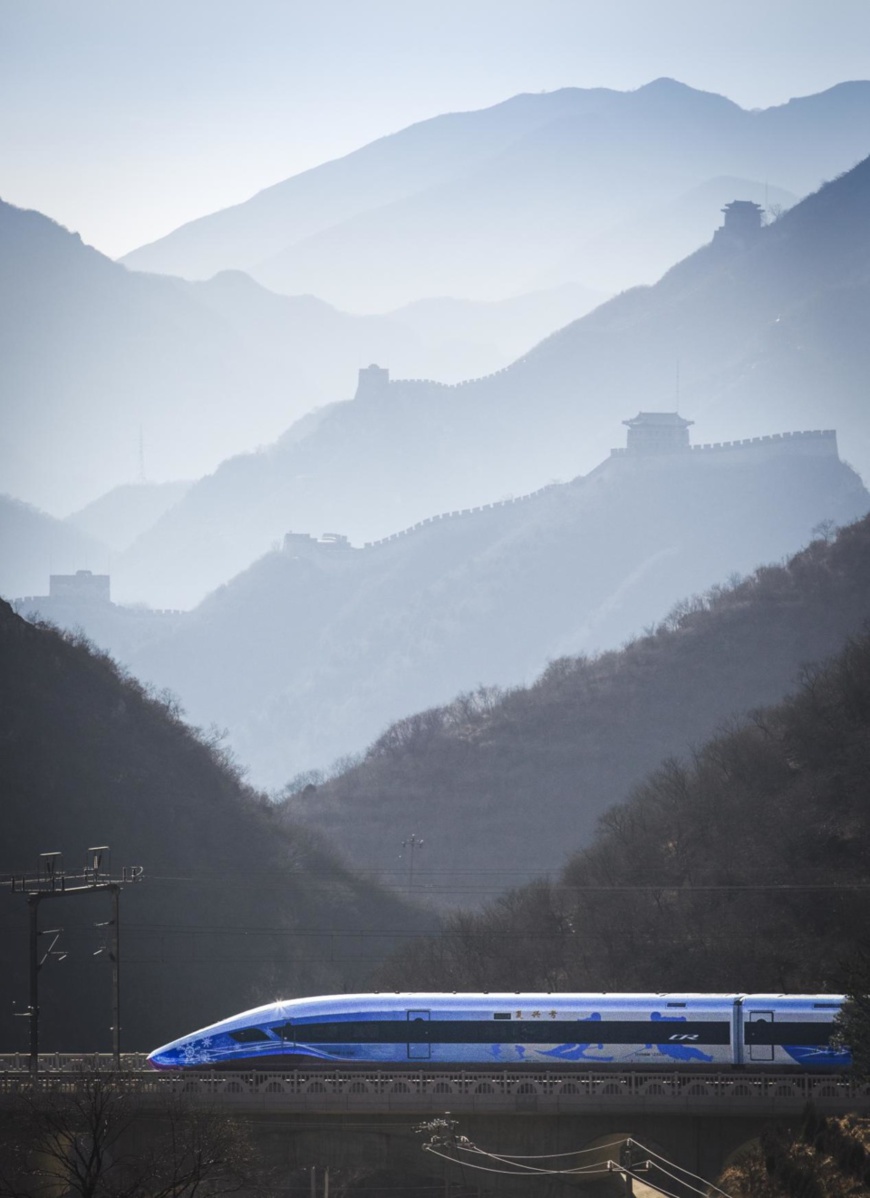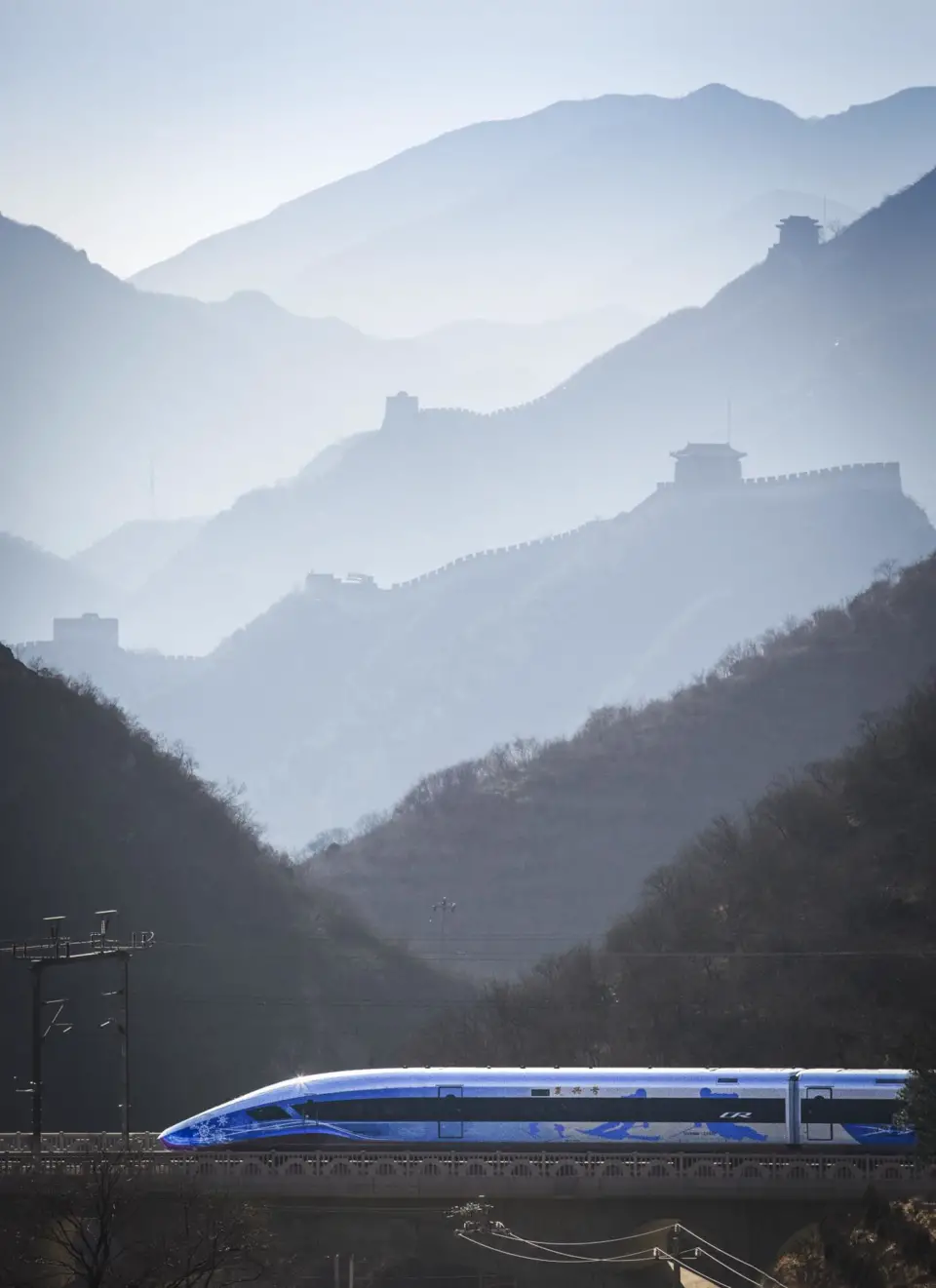By Ji Fang, People’s Daily

A high-speed train custom-made for the Beijing Winter Olympics with a 5G live broadcast studio on board runs on the Beijing-Zhangjiakou high-speed railway, Jan. 6, 2022. (Photo by Xing Ziming/People’s Daily Online)
Technology is profoundly changing China’s winter sports, making the country from one that was absent from many events in Pyeongchang four years ago to a winter sports power that has established teams of all sports events involved in the upcoming Beijing Winter Olympics this year.
Sci-tech progress is contributing to the country’s preparations for the Winter Games in almost all aspects, from specific training to physical training, and from training performance capturing to medical rehabilitation, making the work of athletes more efficient.
For instance, a training assistance system has been equipped at a new winter sports training base in Laiyuan county, north China’s Hebei province to help athletes improve their performance.
After a Nordic combined athlete made a leap from a platform at the base, the speed, take-off angle, dynamic posture, and other data immediately popped up on a screen thanks to the micro wearables worn by the athlete.
The assistance system presents athletes’ training performance with visuals and data, and guides their future training in a science-based way.
Technology is changing how athletes are training themselves for the games. At a national winter sports training and research center, a wind tunnel is employed to help athletes find the dynamic postures that generate the least air resistance. In Beishan Mountain, northeast China’s Jilin province, an air-raid shelter is transformed into a ski resort, where athletes can go training even in the summer.
Apart from training, scientific innovation has also played a very crucial role in the construction of the venues for the Beijing Winter Olympics. It contributed to the site selection and module building of China’s first sliding track, and solved all kinds of technical problems in the construction of a series of venues, including the National Sliding Center and the National Ski Jumping Center.
The National Aquatics Center, known as “Water Cube,” is the world’s first venue that has shifted from a swimming center to a curling sheet. It features multi-zone climate and humidity control, and is able to adapt itself to different sports in very short period of from time.
From the stage of designing and evaluation to construction and operation, scientific innovation is aiding the preparation work for the Winter Games in every aspect.
To some extent, the Olympics wouldn’t have been so popular around the world without the assistance from modern technology.
New technologies are improving the hardware to bring better safety, precision and publicity to the Olympic Games. Besides, they can also constantly renew training methods, mechanisms and other software aspects, to make athletes faster, higher, stronger – together.
Technological innovation is of high importance especially for winter sports, as winter sports athletes usually compete outdoors at high speed wearing a wide range of equipment. Therefore, China, implementing an action plan on the sci-tech innovation of the Winter Games, is sticking to independent innovation while learning advanced technologies from winter sports powers, so as to make constant breakthroughs in its ability to run and broadcast sports events, and to ensure safety of these events.
Technologies applied in winter sports are also expected to have a spillover into relevant industries and the “white economy.” As China prepares to hold the Winter Games, a series of achievements are made by sci-tech innovation in infrastructure, green development and smart city construction. These achievements will become a treasure for the host cities, and continue to contribute to urban development, industrial vitalization and people’s livelihood.
More importantly, such progress, be it the smart equipment used in the games that are later popularized, or the experience in smart venue construction, can help sports grounds across China optimize their management and functions. Technological outcomes achieved in the Winter Games will also improve the general efficiency of China’s winter sports industry, thus bringing higher quality to the rapid development of the sector.
The “Experience Beijing” test events for the Beijing Winter Olympics have concluded, and they were lauded for bringing excellent facilities, venue operations and management.
It’s believed that the approaching Beijing 2022 Winter Olympics and Paralympics will be made a grand event powered by technology, and attract attention from all over the world.
Sci-tech progress is contributing to the country’s preparations for the Winter Games in almost all aspects, from specific training to physical training, and from training performance capturing to medical rehabilitation, making the work of athletes more efficient.
For instance, a training assistance system has been equipped at a new winter sports training base in Laiyuan county, north China’s Hebei province to help athletes improve their performance.
After a Nordic combined athlete made a leap from a platform at the base, the speed, take-off angle, dynamic posture, and other data immediately popped up on a screen thanks to the micro wearables worn by the athlete.
The assistance system presents athletes’ training performance with visuals and data, and guides their future training in a science-based way.
Technology is changing how athletes are training themselves for the games. At a national winter sports training and research center, a wind tunnel is employed to help athletes find the dynamic postures that generate the least air resistance. In Beishan Mountain, northeast China’s Jilin province, an air-raid shelter is transformed into a ski resort, where athletes can go training even in the summer.
Apart from training, scientific innovation has also played a very crucial role in the construction of the venues for the Beijing Winter Olympics. It contributed to the site selection and module building of China’s first sliding track, and solved all kinds of technical problems in the construction of a series of venues, including the National Sliding Center and the National Ski Jumping Center.
The National Aquatics Center, known as “Water Cube,” is the world’s first venue that has shifted from a swimming center to a curling sheet. It features multi-zone climate and humidity control, and is able to adapt itself to different sports in very short period of from time.
From the stage of designing and evaluation to construction and operation, scientific innovation is aiding the preparation work for the Winter Games in every aspect.
To some extent, the Olympics wouldn’t have been so popular around the world without the assistance from modern technology.
New technologies are improving the hardware to bring better safety, precision and publicity to the Olympic Games. Besides, they can also constantly renew training methods, mechanisms and other software aspects, to make athletes faster, higher, stronger – together.
Technological innovation is of high importance especially for winter sports, as winter sports athletes usually compete outdoors at high speed wearing a wide range of equipment. Therefore, China, implementing an action plan on the sci-tech innovation of the Winter Games, is sticking to independent innovation while learning advanced technologies from winter sports powers, so as to make constant breakthroughs in its ability to run and broadcast sports events, and to ensure safety of these events.
Technologies applied in winter sports are also expected to have a spillover into relevant industries and the “white economy.” As China prepares to hold the Winter Games, a series of achievements are made by sci-tech innovation in infrastructure, green development and smart city construction. These achievements will become a treasure for the host cities, and continue to contribute to urban development, industrial vitalization and people’s livelihood.
More importantly, such progress, be it the smart equipment used in the games that are later popularized, or the experience in smart venue construction, can help sports grounds across China optimize their management and functions. Technological outcomes achieved in the Winter Games will also improve the general efficiency of China’s winter sports industry, thus bringing higher quality to the rapid development of the sector.
The “Experience Beijing” test events for the Beijing Winter Olympics have concluded, and they were lauded for bringing excellent facilities, venue operations and management.
It’s believed that the approaching Beijing 2022 Winter Olympics and Paralympics will be made a grand event powered by technology, and attract attention from all over the world.
 Menu
Menu
 Technology makes Winter Games more splendid
Technology makes Winter Games more splendid
















